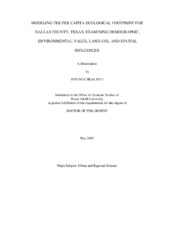| dc.description.abstract | This study addresses factors driving the variation in the per capita Ecological
Footprint (EF) in Dallas County, Texas. A main hypothesis was that scientifically
estimated demography, environmental values, spatial attributes, and land-use patterns
surrounding an individual are significant factors in the size of per capita EF. This study
was based on the survey method and GIS routines. Additionally, a multiple regression
method was employed to address the study question. The survey measured respondents??
EF using an ??Ecological Footprint Quiz?? consisting of sixteen questions regarding
individual food, mobility, housing, and goods/services consumption. GIS technologies
were used to objectively measure spatial attributes. The environmental values were
measured by selected questions regarding ecological crises.
This study found from the descriptive analysis that Dallas County??s average
personal EF was 26.4 acres: food (5.1), mobility (3.3), shelter (8.3), and goods and services (9.8). The study indicates that the residents need ecologically productive land
more than 105 times the area of the county.
Based on the explanatory analysis, the following summary points can be made
about the factors driving of the variance, not only in the per capita composite footprint
but also in each of the personal footprint components:
First, a highly educated, non-married, older male living in a high income
household located in a low population density area is more likely to have a larger
personal composite footprint. Second, a person with a weak environmental awareness
living where the ratio of employment opportunities (places to work) is worse, and living
far from freeways and major lakes but close to major malls, is more likely to have a
larger personal food footprint. Third, a younger person living in a high income
household located close to major malls but far from Dallas/Fort Worth Airport is more
likely to have a larger mobility footprint. Fourth, a highly educated non-married older
male living in a highly developed area is more likely to have a larger shelter footprint.
Fifth, a highly educated non-married older male living in a high income household
located in a low population density area is more likely to have a larger goods and
services footprint. | en |


